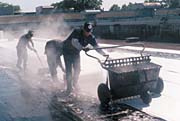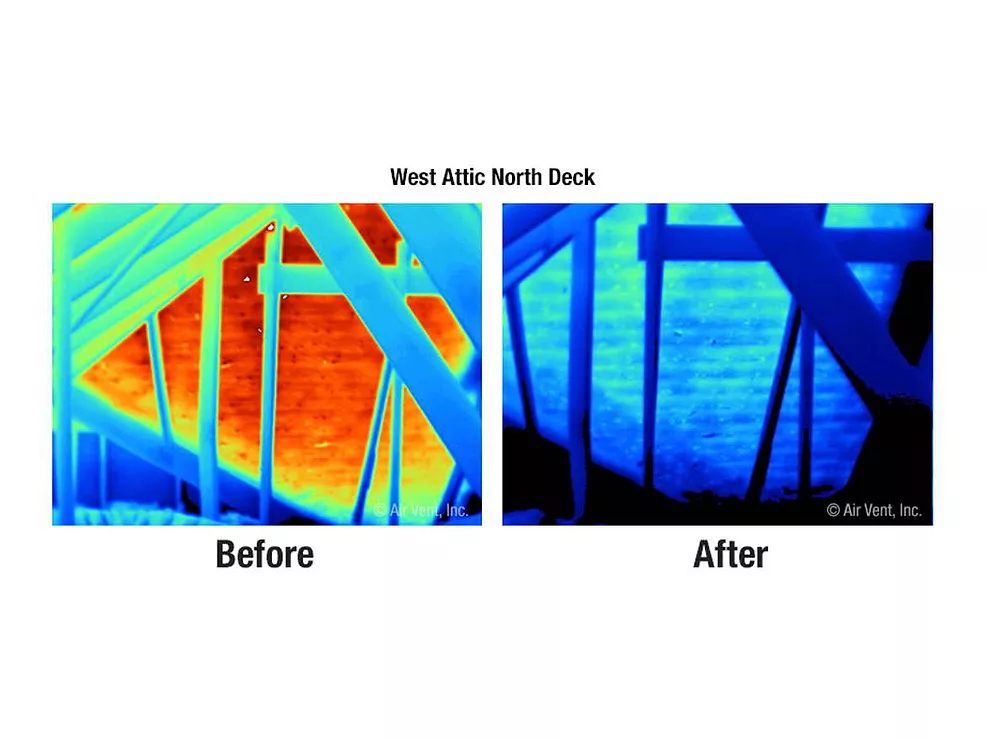The Future of Built-up Roofing: A Pioneer’s Lament
Editor’s note: Jack Hageman is president of Hageman Roofing Com. in Ridgefield Park, N.J., a roof contracting firm founded in 1925. In 1985, Hageman patented the Polara roofing system, a hot built-up roofing system using polyester felts and Type III asphalt.

Yet the continual innovation in roofing suggests that there is a significant market for premium products that provide more than adequate coverage and stop-gap fixes. Those that can save labor or material seem to have a better time of acceptance but the dance between manufacturers, distributors, contractors and owners is a complicated one. The best products don’t automatically rise to the top.
By looking at the evolution of one product — polyester reinforcement for hot built-up roofing — readers can look at the economic, technological, operational and psychological barriers to innovation in commercial roofing. Yes, it is a technique that I patented in 1985, but that patent runs out in 2004. It will be interesting to see whether the industry was waiting in the wings for the patent to expire or if other roadblocks exist.

Home-spun Beginning
How the roofing market embraces a new product is as varied as the contractors themselves. For example, TPO was just a whisper among scientists 10 years ago and now its market share is in double digits. Of course, the roofing landscape is littered with good concepts that had sufficient financial backing but some fundamental flaw or barrier ensured its demise. So what does it take to overcome skepticism, inertia and financial investment with a roofing solution that so many building owners struggle over?Too often that answer is a race to the bottom. No building owner is exempt from the instinct to spend as little as possible. Even owners who have paid consequences for past neglect find reasons for cheap fixes. Still, building owners in general are becoming more sophisticated and there is a large enough market of specialty projects to keep any decent contractor busy.
The usage of polyester in commercial roofing has a diverse and successful history, along with some setbacks. The American market has been a combination of grassroots innovation and corporate interest. For instance, DuPont introduced Reemay® Hot with much fanfare at the 1984 NRCA Convention, but the polyester/fiberglass combine never overcame concerns over price. DuPont was not a traditional roofing manufacturer that offered performance warranties and the high-performing product quickly faded.
Around the same time, modified bitumen, another multi-ply system using asphalt and polyester, was being imported from Europe. By the end of the 1980s, the systems had market share in the double digits. Modified bitumens were prepared membranes produced by numerous manufacturers who also offered warranties, training, accessories and performance ratings, like UL and FM.
While single plies fostered numerous roofing companies that package together materials, BUR has generated few of these “boutique” operations. Is it tradition, inertia or skepticism? Or is BUR perceived as too much of a commodity to make a distinction among buyers?
Single-ply roofing has generated several proprietary membranes that have gained significant inroads, TPO being only the latest example. Single plies have also introduced the merits of polyester as a reinforcement and proved that building owners were willing to pay a premium price for their low-slope roofs. Still, there were many glitches — some disastrous — and single-ply producers are still introducing new methods of attachment that address past problems ranging from delamination of seams to emissions from solvents.
Of course, BUR has experienced its own setbacks. Two-ply systems in the 1960s were a disaster, and there were occasionally problems with asphalt quality, plus the consistency and availability of gravel. There still remains disagreement over the proper application of felts and asphalt, showing that BUR continues to be an art as well as science. Since art commands a wider price range than widgets, it’s sometimes hard to understand why BURs are often devalued.
Two advantages that singles plies had from the beginning involved training and warranties. Single-ply crews were highly trained and scrutinized during the first installations; some manufacturers still recognize select contractors in their promotional campaigns. When there were problems, most single-ply manufacturers honored their warranties even when there were numerous failures to contend with. The learning curve was steep, but there were several large companies committed to capturing a large part of the market share. BUR had provided adequate protection for the most part, so it took more than slick brochures to convince building owners to try these new products. That willingness was based in a large part on genuine concerns about past roof performance of the venerable BURs.
Built-up Business
The evolution of the built-up roof has been glacial compared to single plies, but that may be in large part the inherent resiliency of a properly installed BUR. Still, modifications have proven necessary (low fumes, cap sheets), otherwise BURs wouldn’t continue to lose market share. According to the NRCA’s Annual Market Survey, that slippage was nearly 10 percent from 1995 to 2000. Even in the Sunbelt where BUR numbers are strong, single-ply is still making inroads.Shipments of BUR materials increased due to the expanding economy and some innovation, albeit gradual, continues. In the current economic downturn, the economics and performance of BUR may make it even more attractive to the ever-thrifty building owner. Its resiliency in the face of constant attacks is due to a committed contractor base, excellent performance history, quality materials and a steady manufacturing base. True, it’s hard to make the hot and sticky stuff as sexy as single-ply, yet no one ever said that keeping a building dry was a turn on.
Virtually every commercial building material has undergone a quantum leap during the last 50 years. Steel is coated or painted with new blends that address fire/rust/aesthetic concerns; cement often has additives, techniques or reinforcements recently developed; even glass today is a far cry from the hand-poured, single panes. Granted, BUR contractors are the last guys who want to be hit with “quantum leaps” in technology, because that usually means a quantum investment in training, equipment and operations. It also took a huge investment in manufacturing to convert from organic and asbestos felts to fiberglass, but to me it’s hard to argue today that 50-year-old fiberglass manufacturing equipment needs to be preserved. And polyester requires no additional equipment investment for the traditional BUR contractor other than a really sharp knife and some extra brooms.
There is a Catch 22 regarding polyester for hot BUR: Manufacturers are reluctant to build capacity until there’s a market, but it’s hard to get a market without the capacity. It’s a problem that roofing and many other industries face continually and one that single- ply apparently has overcome, time and again. The production of EPDM roofing membranes represented a huge commitment — one reason for their resolve — but there remain only a few manufacturers. The existing capacity to manufacture spun-bond polyester is enough to meet an increased demand, while existing usage in PVC, modified bitumen and other single plies have given many manufacturers experience in dealing with polyester reinforcements.
Even as BUR enjoys a loyal audience, growth is the nature of any business and new customers must always be pursued. I couldn’t guess the number of times that a building owner complains about having to replace a BUR that’s “only” 20 years old, but it’s similar to the number of single plies that I’ve had to replace prematurely. Perhaps the future of BUR lies in specifications, where the real decisions are often made. It’s a task that no one company wants to take on, because they risk losing all that hard work to a competitor with a pencil that’s a little sharper.
I believe that a trade group like the Asphalt Roofing Manufacturers Association, which does a fine job of promoting its products, could deal more aggressively with architects and specifiers who make the call on system types. (Editor’s note: ARMA is doing just that. See article called "What’s Up with the Asphalt Roofing Manufacturing Industry?") Even local contractor associations could make it part of a broader education issue for area building owners, ensuring that the type of membranes that they believe in get the same attention as the single plies. As in anything, it often comes down to salesmanship.
Recent concerns about proprietary specifications could vanish with a solid and open bid process that qualifies contractors, utilizes objective consultants and allows the broad selection of the many quality materials made by BUR manufacturers around the country. Then the decision would rest upon price — a fair price — with service, system warranties, accessories and maintenance programs making up the difference.
The application of a good BUR still depends upon an experienced crew and their ability to accommodate the many challenges found on modern and historic buildings. There is still room for the individual craftsmen who can seal in the fifth wall without having to continually re-learn a new installation process or refer to thick installation manuals. Once BUR roofers have it, the skill is there for life, provided they have the opportunity to install them.
The codes, materials and distribution are in place; the expertise, equipment and personnel are standing by. And my patent on polyester is just about over. Here’s a product that can be walked on soon after installing, can go right over expansion joints and has more than 200 million square feet of history during the last 20 years (90 percent are one-ply with a base sheet). It’s the only reinforcement that I use and has been successfully installed in many different regions of the country. Several manufacturers offer it, but it’s not the home run I thought it would be.
A more recent invention of mine, Polaralume®, uses an aluminum backing that gives it excellent fire and wind resistance. Polaralume has received an FM-150 rating, a UL Class A fire resistance rating (with a coating), and has passed UL 790. Again, this can be installed in a one-ply system that offers the superior tensile strength, elongation and strain energy that single plies love to tout, with the toughness and puncture resistance of traditional BURs. Plus there are less fasteners, no cover boards and the system offers versatility like phase and cold weather construction. It even eliminates the need for poured, lightweight concrete decks, but fours years after receiving the patent there has been only tepid interest.
Another invention is the same non-woven, heat-resistance polyester sheet that is laminated to a flexible urethane foam. Polarafoam® is designed to smooth over a gravel roof with the loose gravel removed, enabling the ply to lie flatter and resist punctures. When mechanically attached to the deck, it will provide a more level base, allowing any type of roofing system to be applied.
If it sounds like I’m betting the future on polyester, it is my honest assessment that this is the outlook of roofing. We’ve crippled the local re-roofing market, but our customers love us. Even though resistance to BUR innovation is significant, I personally would have hated to be the last guy using organic felts.
Many innovations have come from roofing contractors over the years. The past 20 years has given us many improvements — by contractors and manufacturers — as everyone seeks the Holy Grail. As my concept is set free from patent restrictions, I can only hope that the roofing industry recognizes its potential to revolutionize BUR. Roofing contractors and manufacturers have an opportunity to seize this proven concept and take it to the next level — up.
Looking for a reprint of this article?
From high-res PDFs to custom plaques, order your copy today!



